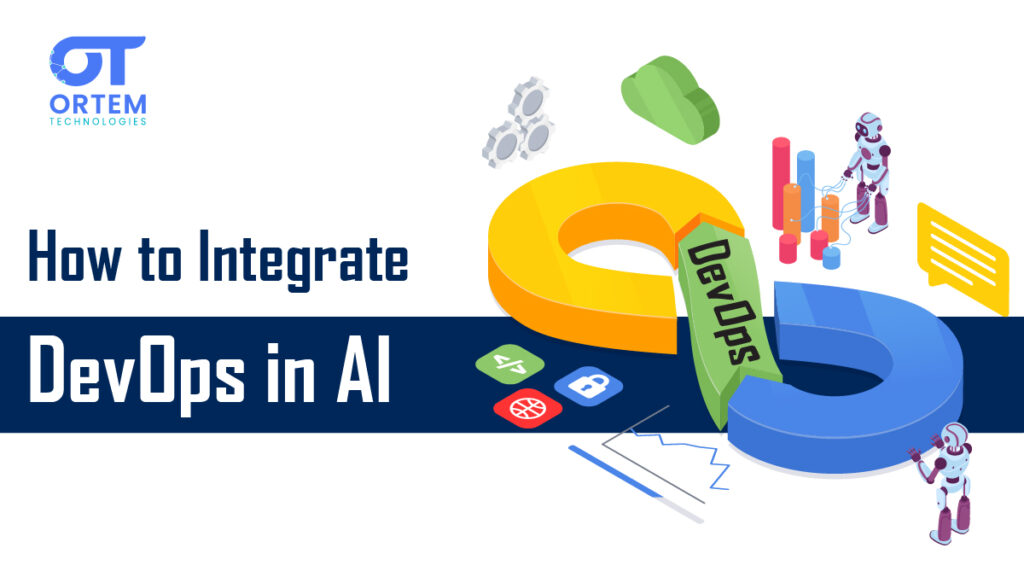As artificial intelligence (AI) moves from experimental to mission-critical, organizations are turning to DevOps to streamline and scale complex AI pipelines. In 2025, best-in-class teams are leveraging DevOps automation, continuous integration and deployment (CI/CD), and cloud-native tools to operationalize AI—delivering faster releases, improved reliability, and greater business value.
This guide explores how your engineering and data science teams can successfully integrate DevOps practices into AI projects, overcome common obstacles, and build scalable, secure, and automated AI delivery pipelines.
Why Integrate DevOps in AI?
DevOps transforms AI from siloed experiments into repeatable, production-grade workflows. The rise of MLOps (Machine Learning Operations) and AIOps (AI for IT operations) means:
- Rapid model deployment using automated CI/CD pipelines
- Proactive monitoring and predictive analytics to reduce downtime
- Streamlined collaboration between data science and ops teams
- Continuous improvement with feedback-driven retraining and versioning
- Security-first approach (DevSecOps) to prevent vulnerabilities in ML code and data
Step-by-Step Guide to DevOps AI Integration
-
Assess Team Readiness and Set Goals
- Align engineering, data science, and operations on shared objectives
- Identify key metrics (model accuracy, deployment frequency, MTTR)
-
Establish CI/CD for AI/ML
- Use Git-based repositories (GitHub, GitLab) for code and model versioning
- Automate training, testing, and deployment in the pipeline (e.g., Jenkins, GitHub Actions)
- Integrate popular MLOps tools like Kubeflow, MLflow, or Vertex AI for reproducibility
-
Adopt Cloud-Native and Microservices Architectures
- Containerize AI models (with Docker) for consistent deployment across environments
- Use Kubernetes or managed cloud services for scalability and auto-healing
- Employ serverless tools for lightweight, on-demand AI inference tasks
-
Automate Testing & Monitoring
- Implement automated unit, integration, and data validation tests in the CI pipeline
- Monitor deployed models with real-time analytics (e.g., Prometheus, Datadog, Seldon Core)
- Set up automated anomaly detection, drift detection, and performance alerts
-
Implement DevSecOps for Compliance & Security
- Integrate security scanning and policy checks throughout the pipeline
- Automate compliance workflows for data privacy (GDPR, HIPAA, etc.)
- Foster a culture where security is everyone’s responsibility
-
Continuous Feedback and Automated Retraining
- Collect and analyze inference data to measure real-world performance
- Trigger automatic retraining pipelines when data drift or model degradation is detected
- Continuous improvement loop: feedback from production powers pipeline iteration
Top Tools for DevOps AI Integration (2025)
-
- CI/CD: Jenkins, GitHub Actions, GitLab CI/CD, CircleCI
- MLOps/AIOps: MLflow, Kubeflow, Vertex AI, Seldon Core
- Monitoring: Prometheus, Datadog, Splunk AIOps
- Infrastructure: Kubernetes, Docker, Terraform, AWS SageMaker, Azure ML
- Security: Snyk, Aqua Security, HashiCorp Vault
Best Practices & Pitfalls
- Start small: Pilot DevOps automation on one or two AI projects before expanding organization-wide.
- Document everything: Version code, models, datasets, and pipelines for full traceability.
- Prioritize transparency and explainability: Use interpretable AI tools in production.
- Don’t skip testing: Data and model validation are essential at every stage.
- Monitor constantly: Production AI without proactive monitoring is a recipe for disaster.
Real-World Use Case: Ortem Technologies Empowers Retailer with DevOps-Driven AI
In early 2025, Ortem Technologies partnered with a national retail chain seeking to transform its inventory and sales forecasting processes. The client faced persistent stockout issues, inconsistent demand prediction, and slow deployment of machine learning models—directly impacting revenue and customer satisfaction.
Implementation:
Ortem deployed a DevOps-powered MLOps solution that combined version-controlled data pipelines, automated CI/CD for machine learning models, and end-to-end monitoring using Jenkins, Docker, and Kubeflow integrated with the retailer’s cloud infrastructure. Key features included:
- Automated training and deployment of demand-forecasting AI models with Git-based version control
- Containerized microservices for scalable and consistent deployment across regions
- Real-time monitoring for model drift and pipeline failures, with automated alerts and rollback
- Continuous feedback loop from sales data to model retraining and improvement
Business Impact:
Within three months, the retailer reported:
- 32% reduction in stockouts across top 100 products
- 21% improvement in forecast accuracy
- Rollout cycle for new AI models dropped from 4 weeks to just 3 days
- Increased sales revenue due to better product availability and reduced lost sales
By integrating DevOps best practices into their AI/ML lifecycle, this business gained agility, robust automation, and measurable improvements demonstrating how Ortem Technologies helps clients turn intelligent automation into true business growth.
Conclusion
DevOps is essential for delivering robust, scalable, and secure AI in 2025 and beyond. By embedding CI/CD, monitoring, automation, and security into every stage of the AI lifecycle, organizations unlock faster time-to-value, improved reliability, and real-world impact from their AI investments. Want help building an end-to-end DevOps pipeline for AI?
Ortem Technologies specializes in custom MLOps and AIOps solutions for enterprises ready to lead the AI-first future. Let’s connect!
